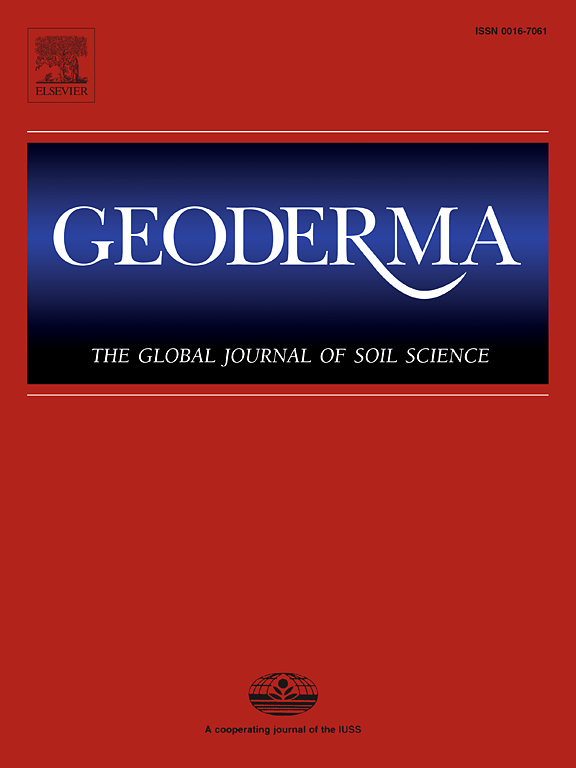CAZyme 家族调控穆乌斯沙漠植被恢复过程中土壤有机碳组成的变化
IF 5.6
1区 农林科学
Q1 SOIL SCIENCE
引用次数: 0
摘要
通过植被恢复防治荒漠化在土壤固碳方面具有巨大潜力。然而,人们对不同植被恢复类型对土壤有机碳成分的影响以及碳水化合物活性酶(CAZymes)作用的了解仍然有限。本研究评估了中国木乌斯沙漠东部四种不同植被类型的土壤,即草原荒漠(GD)、荒漠干草原(DS)、典型干草原(TS)和人工林(AF),考察了理化性质、碳化学成分、微生物群落组成和 CAZyme 基因丰度。我们的研究结果表明,TS 恢复显著增加了土壤有机碳(SOC)的各种成分含量。与其他植被类型相比,土壤中难降解碳的比例(20%-22%)明显较高,并且与木质素和肽聚糖有很强的相关性,这可以通过分析 CAZyme 亚家族的组成来确定。GD 和 DS 土壤中纤维素和半纤维素分解 CAZyme 的含量丰富,导致多糖和脂肪碳含量较高。在不同有机物类型的分解过程中,甲基碳成分发生了显著变化,这与蛋白细菌和酸性细菌的丰度密切相关。我们的研究阐明了不同植被类型对沙质土壤固碳和稳定的影响,强调了微生物群落及其 CAZyme 活动的关键作用。这些见解可以指导加强土地管理策略,改善干旱生态系统的碳动态。本文章由计算机程序翻译,如有差异,请以英文原文为准。
The CAZyme family regulates the changes in soil organic carbon composition during vegetation restoration in the Mu Us desert
Combatting desertification through vegetation restoration holds significant potential for soil carbon sequestration. However, understanding the effects of different restoration types on soil organic carbon component and the role of carbohydrate-active enzymes (CAZymes) remains limited. This study assessed soils from four distinct vegetation types, namely grassland desert (GD), desert steppe (DS), typical steppe (TS), and artificial forest (AF), in the eastern part of the Mu Us Desert, China, examining physicochemical properties, carbon chemical composition, microbial community composition, and CAZyme gene abundance. Our research findings demonstrated that TS restoration significantly increased the content of various soil organic carbon (SOC) components. Compared to other vegetation types, the proportion of recalcitrant carbon (20–22%) was notably higher and exhibited a strong correlation with lignin and peptidoglycan, as determined by the analysis of CAZyme subfamily composition. GD and DS soils showed enrichment in cellulose and hemicellulose-decomposing CAZymes, leading to higher polysaccharide and aliphatic carbon levels. Significant changes were observed in the methyl carbon component amidst the decomposition of varied organic matter types, correlating strongly with Proteobacteria and Acidobacteria abundances. Our research elucidates the influence of distinct vegetation types on sandy soil carbon sequestration and stabilization, highlighting the crucial function of microbial communities and their CAZyme activities. These insights can guide enhanced land management strategies for improved carbon dynamics in arid ecosystems.
求助全文
通过发布文献求助,成功后即可免费获取论文全文。
去求助
来源期刊

Geoderma
农林科学-土壤科学
CiteScore
11.80
自引率
6.60%
发文量
597
审稿时长
58 days
期刊介绍:
Geoderma - the global journal of soil science - welcomes authors, readers and soil research from all parts of the world, encourages worldwide soil studies, and embraces all aspects of soil science and its associated pedagogy. The journal particularly welcomes interdisciplinary work focusing on dynamic soil processes and functions across space and time.
 求助内容:
求助内容: 应助结果提醒方式:
应助结果提醒方式:


